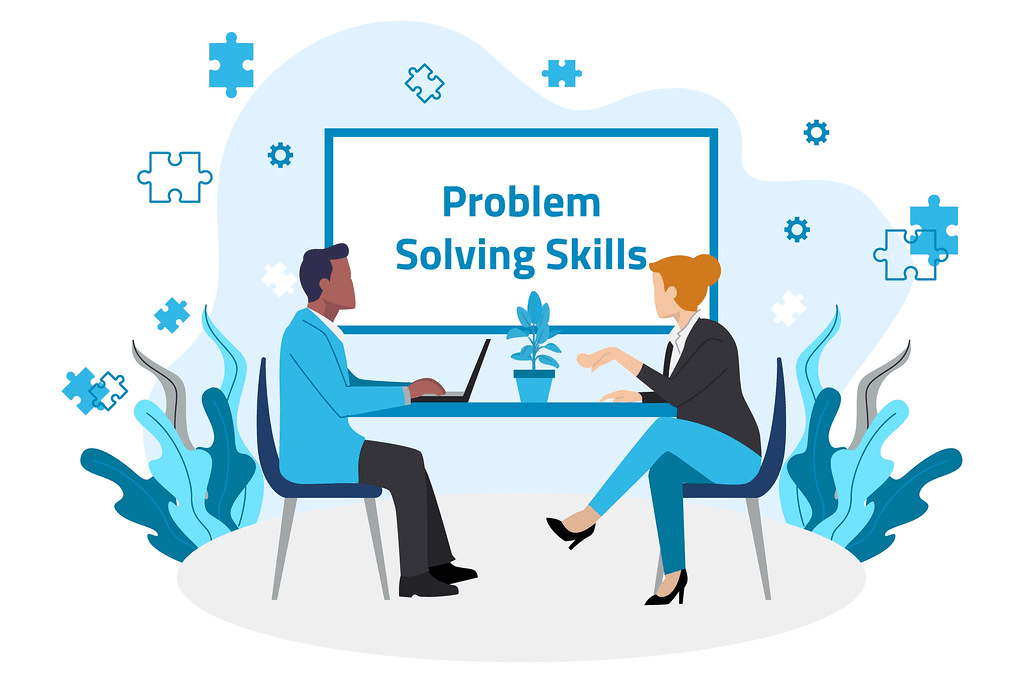As a business owner or entrepreneur, challenges and obstacles are inevitable. However, what sets successful businesses apart is their ability to effectively tackle and overcome these challenges by problem-solving in business. In other words, how well are they able to problem-solve? I would like to give some tips on how successful business owners are able to look at a problem objectively, break it down, and find the best solution.

Understanding the Role of Problem-Solving in Business:
1. The Foundation of Business Success
At the core of every thriving business is the ability to confront and overcome challenges. This can range from external factors such as market fluctuations and economic uncertainties to internal issues like operational inefficiencies and personnel management. Businesses are constantly presented with a spectrum of problems that demand attention. The capacity to address these challenges effectively is synonymous with a proper problem-solving skillset, and often a CEO mindset.
In essence, problem-solving is not just about fixing what is broken; it is about seizing opportunities and optimizing processes. Successful businesses and owners view problems as temporary setbacks, but if treated properly they are a gateway to improvement, innovation, and growth. By recognizing problems as an inevitable aspect of business, organizations can adopt a proactive stance, positioning themselves to not only weather storms but also to thrive amid adversity.
2. Adapting to Changes in Your Environment
Technological advancements, changes in consumer behavior, and global economic shifts cause the marketplace and business to be constantly changing. When this is happening, being unable to adapt and problem-solve appropriately will ultimately take a business under as they are not able to keep up with the demand for change.
Adaptability is a key benefit of problem-solving and allows businesses to navigate the changing marketplace and capitalize on emerging opportunities. By fostering a culture that encourages flexibility and continuous improvement, organizations position themselves as agile entities capable of responding effectively to external changes. Problem-solving, in this context, becomes a strategic tool for not just survival but also for gaining a competitive edge.
3. Strategic Decision-Making:
Informed decisions require an understanding of the challenges at hand, and effective problem-solving provides the framework for such understanding.
Strategic decision-making involves assessing various options, weighing risks and benefits, and aligning choices with overall business objectives. Problem-solving skills enable business leaders and decision-makers to analyze data, identify root causes, and design solutions that align with the organization’s strategic goals. Whether it’s entering a new market, introducing a new product, or restructuring internal processes, strategic decisions guided by effective problem-solving contribute to the sustainable growth of a business.
The foundation of business success is intricately tied to the owner and employees’ ability to solve problems strategically. By embracing challenges as opportunities, fostering adaptability in a changing marketplace, and integrating problem-solving into your strategic decision-making processes, businesses set the stage for resilience, innovation, and long-term success.

Key Components of Effective Problem Solving:
1. Analytical Thinking: The Foundation of Effective Problem Solving
Analytical thinking is the bedrock of effective problem-solving in business. It involves breaking down complex issues into manageable components, examining relationships between these components, and discerning patterns and trends. Businesses often face multifaceted challenges, and the ability to analyze data and information critically is vital.
In the realm of analytical thinking, tools like data analytics, statistical analysis, and diagnostic processes play a vital role. These tools empower businesses to sift through vast datasets, identify correlations, and uncover the root causes of problems. For instance, a retail business facing a decline in sales may use analytical thinking to dissect customer purchasing patterns, market trends, and competitive strategies to pinpoint the reasons behind the downturn. If doing the analysis yourself feels overwhelming, there are many software and professionals available to assist you.
2. Creative Problem Solving: Nurturing Innovation for Business Success
While analytical thinking is structured and systematic, creative problem-solving introduces an element of innovation and originality. Creativity is the force that propels businesses beyond conventional solutions toward inventive and groundbreaking answers to challenges.
Encouraging creative problem-solving involves fostering a workplace culture that values diverse perspectives, out-of-the-box thinking, and risk-taking. Google’s famous 20% time policy, where employees are encouraged to spend a portion of their work hours on personal projects, is a prime example of how fostering creativity can lead to innovations such as Gmail and Google Maps.

3. Collaborative Problem-Solving: Harnessing Collective Intelligence
Challenges are seldom confined to a single department or individual. Collaborative problem-solving involves bringing together different talents and perspectives to address complex issues.
Cross-functional teams, composed of members from different departments with varied expertise, can provide a holistic view of a problem. This diversity fosters an environment where unique insights and approaches emerge, leading to more effective and well-rounded solutions. Businesses that prioritize collaborative problem-solving often witness improved teamwork, communication, and a shared sense of responsibility and accountability.
4. Decision-Making Frameworks: Structuring Solutions Strategically
Effective problem-solving is not just about identifying issues but also about making informed decisions to address them. Decision-making frameworks provide structured methodologies for evaluating options, assessing risks, and choosing the most viable solutions.
- SWOT Analysis: This framework helps businesses identify their Strengths, Weaknesses, Opportunities, and Threats. By understanding internal and external factors, businesses can make strategic decisions aligned with their capabilities and market conditions.
- Cost-Benefit Analysis: When faced with multiple solutions, businesses can use cost-benefit analysis to assess the financial implications of each option. This framework helps in making decisions that maximize benefits while minimizing costs.
- Risk Assessment: Risk assessment frameworks assist in evaluating potential risks associated with each solution, allowing organizations to proactively manage and mitigate risks.
These decision-making frameworks act as guiding tools to help you clearly define potential solutions after you have found your key problems. While I can’t recommend following any of them religiously. I can, however, recommend mixing and matching for the needs of your business to find a potential solution.
Integrating Key Components for Holistic Problem-Solving
While each of these components plays a distinct role, the synergy between them enhances problem-solving efficacy and creates a more holistic approach to your problems. Analytical thinking provides the foundation for understanding the intricacies of a problem, creative problem-solving introduces innovation into the workspace, collaborative problem-solving gathers diverse insights, and decision-making frameworks help structure these insights into strategic actions.
Consider a manufacturing business experiencing quality control issues. Analytical thinking helps identify the root causes through data analysis. Creative problem-solving may involve brainstorming new quality control methodologies. Collaborative problem-solving ensures that insights from production, engineering, and quality assurance are considered. Lastly, decision-making aids in choosing the most viable solution in terms of effectiveness and cost.

Developing Problem-Solving Skills in the Workforce:
Problem-solving skills are not only crucial at the leadership level but also within the broader workforce. Organizations must invest in cultivating these skills among their employees to ensure adaptability, innovation, and sustained success.
Training and Development Programs:
Effective problem-solving is a skill that can be honed and developed. Businesses that recognize the importance of this skill often implement training and development programs. These programs go beyond traditional methods and leverage modern approaches, such as workshops, simulations, and online courses.
One successful example is Google’s “Solve for X” initiative, where employees are encouraged to work on moonshot projects that tackle global challenges. This not only enhances problem-solving skills but also fosters a culture of creativity and innovation within the organization. Investing in such programs not only equips employees with the tools to navigate challenges but also communicates to them that the organization values continuous improvement and is committed to their professional growth.
Cultivating a Problem-Solving Culture:
Beyond formal training, cultivating a problem-solving culture is paramount to embedding these skills within the workforce. This involves creating an environment where employees feel empowered to identify and address challenges without fear of repercussions. Leadership plays a pivotal role in setting the tone for such a culture.
One company that excels in fostering a problem-solving culture is Toyota. The Toyota Production System encourages every employee, regardless of their role, to identify problems and suggest improvements. This approach not only enhances problem-solving skills but also contributes to a more efficient and adaptive organization.
To implement such a culture, organizations can establish forums for idea-sharing, recognize and reward problem-solving initiatives, and provide platforms for cross-functional collaboration. When employees feel that their contributions are valued, they are more likely to actively engage in problem-solving endeavors.
Continuous Learning and Adaptation:
Organizations must promote a culture of continuous learning and adaptation. This involves encouraging employees to stay informed about industry trends, emerging technologies, and evolving challenges.
Salesforce, a leading customer relationship management platform, provides a model example of continuous learning. The company invests in its employees’ education through Trailhead, an interactive learning platform. This not only helps enhance technical skills but also provides employees the opportunity to practice real-world problem-solving.
Additionally, organizations can facilitate mentorship programs, cross-functional team projects, and participation in industry conferences to expose employees to diverse perspectives and experiences. By embracing a commitment to continuous learning, employees become more capable and better equipped to tackle challenges.
In Conclusion: Develop Problem-Solving in Business
Developing problem-solving skills within the workforce is not just a one-time initiative but an ongoing commitment to the growth and adaptability of the organization and employees. By implementing effective training programs, fostering a problem-solving culture, and promoting continuous learning, businesses can empower their employees to navigate challenges with confidence, contributing to a resilient and innovative organizational ecosystem.
In every problem lies an opportunity. It is through effective problem-solving that businesses not only navigate challenges but also uncover opportunities, turning obstacles into stepping stones toward growth. As businesses and technology continue to evolve, those adept at problem-solving will not only weather storms but emerge stronger, armed with the resilience and innovation needed to thrive.
The articles you write help me a lot and I like the topic
Your articles are extremely helpful to me. May I ask for more information?
I really appreciate your help
Thank you for your post. I really enjoyed reading it, especially because it addressed my issue. It helped me a lot and I hope it will also help others.
Well I really enjoyed studying it. This post provided by you is very effective for correct planning.
This platform is unbelievable. The magnificent data uncovers the distributer’s excitement. I’m shocked and expect additional such astonishing entries.
F*ckin?awesome things here. I am very glad to see your article. Thanks a lot and i’m looking forward to contact you. Will you kindly drop me a mail?
Appreciating the time and energy you put into your site and in depth information you offer. It’s good to come across a blog every once in a while that isn’t the same unwanted rehashed material. Excellent read! I’ve bookmarked your site and I’m adding your RSS feeds to my Google account.
I believe this is among the so much significant information for me. And i am happy reading your article. But want to commentary on few normal things, The site taste is great, the articles is in point of fact great : D. Excellent activity, cheers
I sincerely enjoyed what you have produced here. The design is refined, your authored material trendy, yet you appear to have obtained a degree of apprehension regarding what you aim to offer next. Certainly, I shall return more frequently, just as I have been doing almost constantly, provided you uphold this incline.
What a fantastic resource! The articles are meticulously crafted, offering a perfect balance of depth and accessibility. I always walk away having gained new understanding. My sincere appreciation to the team behind this outstanding website.
Comments are closed.